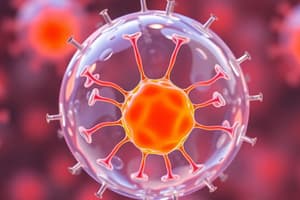Podcast
Questions and Answers
What is the primary characteristic of fatty change or steatosis?
What is the primary characteristic of fatty change or steatosis?
- The deposition of lipids in arterial walls
- The accumulation of cholesterol within the cytoplasm of cells
- The abnormal reversible accumulation of triglycerides within the cytoplasm of cells (correct)
- The buildup of saturated fats in the bloodstream
What is the primary cause of high cholesterol levels in the blood in familial hypercholesterolemia?
What is the primary cause of high cholesterol levels in the blood in familial hypercholesterolemia?
- Abnormalities in liver function
- High dietary intake of saturated fats and cholesterol-rich foods
- Impaired pancreatic function
- Genetic mutations affecting lipid metabolism (correct)
Which condition is characterized by the deposition of cholesterol in arterial walls?
Which condition is characterized by the deposition of cholesterol in arterial walls?
- Obesity
- Atherosclerosis (correct)
- Diabetes mellitus
- Steatosis
What is the term for the accumulation of cholesterol within cells?
What is the term for the accumulation of cholesterol within cells?
What is the term for the visible accumulation of cholesterol in the skin, often seen in conditions like atherosclerosis?
What is the term for the visible accumulation of cholesterol in the skin, often seen in conditions like atherosclerosis?
What is the term for the excessive deposition of mucin, a glycoprotein that forms the major constituent of mucus, within cells or tissues?
What is the term for the excessive deposition of mucin, a glycoprotein that forms the major constituent of mucus, within cells or tissues?
Which of the following is NOT a cause of hyalinosis?
Which of the following is NOT a cause of hyalinosis?
What is the characteristic appearance of amyloid protein accumulation under polarized light?
What is the characteristic appearance of amyloid protein accumulation under polarized light?
Which of the following conditions is associated with the accumulation of mucin in the dermis?
Which of the following conditions is associated with the accumulation of mucin in the dermis?
What is the term for the deposition of a homogenous, glassy, pink material within cells or in the extracellular space?
What is the term for the deposition of a homogenous, glassy, pink material within cells or in the extracellular space?
Which of the following is a typical cause of myxomatous degeneration?
Which of the following is a typical cause of myxomatous degeneration?
What is the underlying mechanism of brown atrophy of the heart?
What is the underlying mechanism of brown atrophy of the heart?
Which of the following is a characteristic of lead poisoning?
Which of the following is a characteristic of lead poisoning?
What is the primary cause of carbon poisoning?
What is the primary cause of carbon poisoning?
Which of the following is a characteristic of anthracosis?
Which of the following is a characteristic of anthracosis?
What is the underlying mechanism of uric acid accumulation?
What is the underlying mechanism of uric acid accumulation?
Which of the following is a potential consequence of uric acid accumulation?
Which of the following is a potential consequence of uric acid accumulation?
What is the term for the disease involving accumulation of excess hemosiderin?
What is the term for the disease involving accumulation of excess hemosiderin?
Which of the following is NOT a cause of jaundice?
Which of the following is NOT a cause of jaundice?
What is the term for the pigment responsible for skin pigmentation?
What is the term for the pigment responsible for skin pigmentation?
What is the term for the iron-free pigment that increases in the liver in case of jaundice?
What is the term for the iron-free pigment that increases in the liver in case of jaundice?
What is the term for the accumulation of lipofuscin in cells, often referred to as the 'wear and tear' pigment?
What is the term for the accumulation of lipofuscin in cells, often referred to as the 'wear and tear' pigment?
What is the genetic disorder of iron absorption that causes hemochromatosis?
What is the genetic disorder of iron absorption that causes hemochromatosis?
What is the primary factor that contributes to the accumulation of MSU crystals?
What is the primary factor that contributes to the accumulation of MSU crystals?
What is the term that describes the deposition of calcium salts in damaged or necrotic tissues?
What is the term that describes the deposition of calcium salts in damaged or necrotic tissues?
Which of the following is NOT a cause of metastatic calcification?
Which of the following is NOT a cause of metastatic calcification?
What is the characteristic appearance of calcium deposits under polarized light?
What is the characteristic appearance of calcium deposits under polarized light?
What is the term that describes the destruction of bone tissue by malignant tumors?
What is the term that describes the destruction of bone tissue by malignant tumors?
Flashcards are hidden until you start studying




